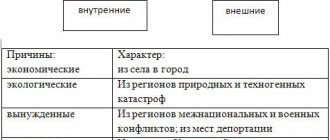Concepts and indicators used in external migration statistics
The concept of external migration is considered as the movement of population between countries (from one country to another), accompanied by a change of citizenship. Migrants who arrive in another country can retain their citizenship without changing it for a long time. Often many of them are classified as stateless persons. Emigrants are those citizens who leave their country, go to live outside its borders, that is, they emigrate from the country. Immigrants, on the contrary, are foreign citizens who come to the country for permanent (long-term) residence.
The system of migration indicators used by statistical services makes it possible to study the different components of migration flows per 1000 people. These include relative and absolute indicators that help track the scale, intensity, direction, effectiveness, and efficiency of migration processes, including labor flows. In simple words, who moves, where, from where, in what quantity.
Concepts
Among the theoretical justifications for external migration (external population movement), the following four concepts should be highlighted.
Neoclassical concept of migration
This concept is the first detailed justification for the movement of labor. It is based on the postulates of the scientist J. Hicks, author of the theory of industrial conflict . It was his work “The Theory of Wages” that became the basis of the neoclassical concept, which was developed on international differences in wage levels.
Actually, this difference, according to the concept, represents the motivation for external migration. Well, the different levels of wages are, in turn, due to the uneven distribution of labor and capital. International movement of labor has a significant impact on such differences. In particular, it directly and indirectly contributes to the adjustment, equalization of income levels, as well as stabilization of the labor market in the international arena.
In the first case, with direct influence, we are talking about increasing the demand and supply for labor in a country where there is not enough of it, there is clearly not enough of it. And vice versa, a decrease in demand and supply for labor where there is a surplus. Indirect influence is exercised through the international transfer of migrants.
Concepts of the new economy of migration
The limitations of the neoclassical concept are fully compensated by the “new economics of migration”. This theory is based on the following judgments and assumptions:
- The object of study of migration processes is the family (household).
- Different levels of earnings are not considered the main incentive or condition for migration.
- Employment and highly developed production at the place of permanent residence do not exclude migration or prevent it. There is another, stronger motivation that encourages migration.
Important! Migration movement may not stop when earnings in the country of departure and country of entry are equalized.
Labor market duality concept
Dualism or duality is a kind of challenge to “neoclassicism”. The concept of dualism was embodied in an attempt to show the integral relationship between the country of departure and entry. It comes from the economic relations existing between countries.
In this regard, the labor market is considered, relatively speaking, as divided into two sectors. Each of them has its own laws regulating employment and determining wage levels. The coexistence of these two sectors represents the essence of duality, the duality of the labor market. Ultimately, the concept comes down to the development of intereconomic relations, equalizing supply and demand in the domestic labor market.
The concept of a global migration system
Based on the world-system theory of I. Wallerstein. Its essence lies in the fact that globalization processes lead to increased external labor migration, which seems to be a natural phenomenon. Migration processes affect the population and the labor market, resulting in mutual exchange, which is a necessary component of everyday life.
Indicators (volume, gain, intensity)
Data on statistical indicators of migration registration are prepared by the relevant authorized bodies involved in the registration (registration) of citizens who have changed their place of residence. Foreigners and stateless persons who have been staying in the territory of a third-party state for more than a year are also subject to this registration. Based on this summary information, external migration statistics are calculated. Absolute indicators are used to quantitatively characterize migration. These include:
- Number of emigrants (E, people). The indicator characterizes the number of foreigners who arrived in the country during a specific period for the purpose of changing their place of residence or staying for more than a year.
- Number of immigrants (I, people). The indicator characterizes the number of citizens who left their country during a specific period for the purpose of changing their place of residence or staying in another country for more than a year.
- The balance of migration (SM = E – I, people) is the migration increase (or outflow). This indicator is often called net migration. It can be positive (there are more emigrants than immigrants) and negative when there are more immigrants.
- Turnover or volume of migration (OM = E + I, people). It is used to characterize the absolute size of migration, since it summarizes data on emigrants and immigrants for the corresponding period.
The obtained values of migration volume indicators may differ. This is due to the fact that during the period under study one citizen can migrate more than once.
| Business valuation | Financial analysis according to IFRS | Financial analysis according to RAS |
| Calculation of NPV, IRR in Excel | Valuation of stocks and bonds |








